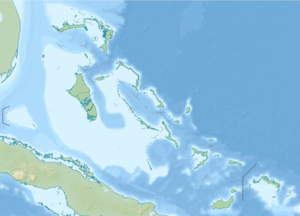Abaco (Bahamas)
| Abaco | ||
|---|---|---|
| Hope Town lighthouse | ||
| Waters | Atlantic Ocean | |
| archipelago | Bahamas | |
| Geographical location | 26 ° 28 ′ N , 77 ° 5 ′ W | |
|
|
||
| Number of islands | around 15 | |
| Main island | Great Abaco | |
| Total land area | 1,681 km² | |
| Residents | 17,224 (2010) | |
| Districts of Abaco | ||
The Abaco Islands are a group of islands in the north of the Bahamas .
geography
The Abaco Islands are the second largest group of islands in the Bahamas. In addition to the two main islands Great Abaco and Little Abaco, they include numerous smaller islands such as Wood Cay , Green Turtle Cay , Great Guana Cay , Castaway Cay (formerly: Gorda Cay), Elbow Cay , Man-o-War Cay , Stranger's Cay , Umbrella Cay , Walker's Cay, and Moore's Island .
history
The native inhabitants of Abaco were the Lucaya Indians, who emerged from the Taíno and established the first permanent settlements here around the 10th century. The Lucaya named the islands Habacoa . After the discovery of America in 1492 by the Spanish colonial empire , they were enslaved and forced to work in the sugar cane plantation and gold mines of Hispaniola , and later to do pearl diving on Cubagua . They were extinct within five decades.
In 1625 the French tried in vain to colonize the island .
During the American Revolution , Abaco, like Cat Island, served as a "safe haven" for British loyalists fleeing the newly independent United States . They probably founded the New Plymouth settlement on Green Turtle Cay in the 1770s . The first settlement on the main island was established in 1783 by 600 refugees from New York on the north end of Treasure Cay . It was named after the British general in North America Sir Guy Carleton Carleton Point . Two years later the settlement was hit by a hurricane and as a result it was abandoned. The settlers moved south, founded Marsh Harbor and settled other places on the coast of the main islands and smaller cays .
The number of inhabitants grew rapidly to around 2000, who initially grew cotton successfully . However, when the yields decreased after a few years due to pests and deterioration in soil fertility, many boilers migrated again and only about 400 remained on the islands. The economic basis was now fishing , shipbuilding and the salvage of cargo from crashed ships. During the American Civil War in the 1860s, the inhabitants profited from smugglers and Confederate blockade breakers who hid their ships in the bays from the navy of the Union states . The end of the war heralded a recession on Abacos. During the time of Prohibition in the United States , the island's residents participated in the profitable alcohol smuggling.
On September 1, 2019, the Abaco Islands were hit by Category 5 Hurricane Dorian . Around 90 percent of the houses and infrastructure on the island were destroyed.
population
The total population of the Abaco Islands is around 17,200 people, of which over 4,400 are Haitians . The administrative and economic center is Marsh Harbor .
Economy and Infrastructure
Originally the most important branches of industry on Abaco were shipbuilding and fishing , meanwhile tourism and the cultivation of citrus fruits dominate .
The islands are a well-known base for sailing activities in the Bahamas and a tourism hub. The red and white striped lighthouse on Elbow Cay near Hope Town is a well-known local attraction.
Web links
- Shark rodeo on Abaco
- The Bahamas Guide
- History of the Bahamas ( Memento from December 22, 2007 in the Internet Archive )
- Shark info
Individual evidence
- ^ Abaco: Island Information. Bahamian government website. Retrieved September 9, 2019.
- ↑ Jeffrey P. Blick: The Bahamas and the Turks and Caicos Islands. In: Basil A. Reid, R. Grant Gilmore (Eds.): Encyclopedia of Caribbean Archeology. University Press of Florida, 2017, p. 58, online at issuu.com (English).
- ^ Prehistory of the Bahamas / TCI. Stone interchanges within the Bahama archipelago - University of Oxford. Retrieved September 9, 2019.
- ↑ a b c Gaylord Dold: The Bahamas. Rough Guides, London / New York City 2003, ISBN 1-85828-828-2 , p. 132 ( limited preview in Google Book Search, English).
- ^ Sandra Riley: Homeward Bound: A History of the Bahama Islands to 1850 with a Definitive Study of Abaco in the American Loyalist Plantation Period. 4th edition, Riley Hall, Miami 2000, ISBN 0-9665310-2-7 , pp. 16-19 ( limited preview in Google book search, English).
- ↑ Greyson Beights: Abaco History. In: theabaconian.com . June 22, 2018, accessed on September 13, 2019.
- ^ Carleton Point. Bahamian Ministry of Tourism website. Retrieved September 9, 2019.
- ↑ Abaco. Bahamas National Trust. Retrieved September 13, 2019.
- ^ Local History of Treasure Cay & the Abacos. In: bahamabeachclub.com . Retrieved September 13, 2019.
- ↑ Hurricane Dorian: WFP Support to the NEMA / CDEMA-led humanitarian response in the Bahamas Situation Report # 03, 10 September 2019. WFP in: reliefweb.int . September 10, accessed on September 12, 2019.
- ↑ Abaco 2010 Census of Population and Housing. Government of the Bahamas, 2013, p. 39. Retrieved September 13, 2019 (PDF; 14.1 MB; English).
- ↑ Abaco. In: britannica.com . Accessed September 7, 2019.


